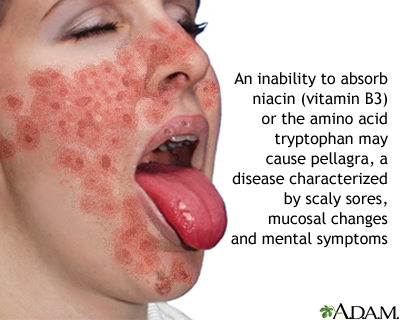Pellagra
Vitamin B3 deficiency; Deficiency - niacin; Nicotinic acid deficiency
Pellagra is a disease that occurs when a person does not get enough niacin (one of the B complex vitamins) or tryptophan (an amino acid).
Images

Causes
Pellagra is caused by having too little niacin or tryptophan in the diet. It can also occur if the body fails to absorb these nutrients.
Pellagra may also develop due to:
- Gastrointestinal diseases
- Weight loss (bariatric) surgery
- Anorexia
- Excessive alcohol use
- Carcinoid syndrome (group of symptoms associated with carcinoid tumors of the small intestine, colon, appendix, and bronchial tubes in the lungs)
- Certain medicines, such as isoniazid, 5-fluorouracil, 6-mercaptopurine, pyrazinamide, hydantoin, ethionamide, phenobarbital, azathioprine, and chloramphenicol
Pellagra is most common among poor and food-limited populations. The disease is more common in parts of the world (such as certain parts of Africa) where people have a lot of untreated corn in their diet. Corn is a poor source of tryptophan, and niacin in corn is tightly bound to other components of the grain. Niacin is released from corn if soaked in limewater overnight. This method is used to cook tortillas in Central America where pellagra is rare. Pellagra is rare in the United States and may be associated with severe alcoholism or medical causes of malnutrition.
Symptoms
Symptoms of pellagra include:
- Delusions or mental confusion
- Diarrhea
- Weakness
- Loss of appetite
- Pain in abdomen
- Inflamed mucous membrane
- Scaly skin sores, especially in sun-exposed areas of the skin
Exams and Tests
Your health care provider will perform a physical exam. You will be asked about the foods you eat.
Tests that may be done include urine tests to check if your body has enough niacin. Blood tests may also be done.
Treatment
The goal of treatment is to increase your body's niacin level. You will be prescribed niacin supplements. You may also need to take other supplements. Follow your provider's instructions exactly on how much and how often to take the supplements.
Symptoms due to the pellagra, such as skin sores, will be treated.
If you have conditions that are causing the pellagra, these will also be treated.
Outlook (Prognosis)
People often do well after taking niacin.
Possible Complications
Left untreated, pellagra can result in nerve damage, particularly in the brain and death. Skin sores may become infected.
When to Contact a Medical Professional
Contact your provider if you have any symptoms of pellagra.
Prevention
Pellagra can be prevented by following a well-balanced diet.
Get treated for health problems that may cause pellagra.
Related Information
NiacinTryptophan
References
Mason JB, Booth SL. Vitamins, trace minerals, and other micronutrients. In: Goldman L, Cooney KA, eds. Goldman-Cecil Medicine. 27th ed. Philadelphia, PA: Elsevier; 2024:chap 199.
Meisenberg G, Simmons WH. Micronutrients. In: Meisenberg G, Simmons WH, eds. Principles of Medical Biochemistry. 4th ed. Philadelphia, PA: Elsevier; 2017:chap 31.
So YT. Deficiency diseases of the nervous system. In: Jankovic J, Mazziotta JC, Pomeroy SL, Newman NJ, eds. Bradley and Daroff's Neurology in Clinical Practice. 8th ed. Philadelphia, PA: Elsevier; 2022:chap 85.
BACK TO TOPReview Date: 10/27/2024
Reviewed By: Laura J. Martin, MD, MPH, ABIM Board Certified in Internal Medicine and Hospice and Palliative Medicine, Atlanta, GA. Also reviewed by David C. Dugdale, MD, Medical Director, Brenda Conaway, Editorial Director, and the A.D.A.M. Editorial team.

Health Content Provider
06/01/2025
|
A.D.A.M., Inc. is accredited by URAC, for Health Content Provider (www.urac.org). URAC's accreditation program is an independent audit to verify that A.D.A.M. follows rigorous standards of quality and accountability. A.D.A.M. is among the first to achieve this important distinction for online health information and services. Learn more about A.D.A.M.'s editorial policy, editorial process and privacy policy. A.D.A.M. is also a founding member of Hi-Ethics. This site complied with the HONcode standard for trustworthy health information from 1995 to 2022, after which HON (Health On the Net, a not-for-profit organization that promoted transparent and reliable health information online) was discontinued. |
The information provided herein should not be used during any medical emergency or for the diagnosis or treatment of any medical condition. A licensed medical professional should be consulted for diagnosis and treatment of any and all medical conditions. Links to other sites are provided for information only -- they do not constitute endorsements of those other sites. © 1997- 2025 A.D.A.M., a business unit of Ebix, Inc. Any duplication or distribution of the information contained herein is strictly prohibited.
